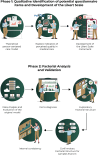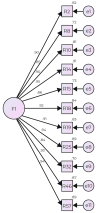Design and validation of an instrument to evaluate Person-Centered care in health services
- PMID: 39138545
- PMCID: PMC11323455
- DOI: 10.1186/s13690-024-01324-2
Design and validation of an instrument to evaluate Person-Centered care in health services
Abstract
Background: The concept of quality in health care has evolved, placing greater importance on the patient's needs, culture, and social context, as well as their participation in clinical decision-making, as highlighted by Mead and Bower's Person-Centered Care Model. The aim of the present study was to design and validate an instrument to assess the extent to which healthcare services provided by PEMEX (Petróleos Mexicanos) offer person-centered care according to user perceptions.
Methods: The first phase comprised the development of 57 items based on the analysis of responses from an open-ended questionnaire administered to 30 users of Pemex healthcare services. This questionnaire was designed considering the four factors of the person-centered care model, however, the high correlation between the 4 factors (i.e., r ≥ .80) indicated an overfactoring effect and consequently an increase in the risk of overfitting. Therefore, an exhaustive analysis of the instrument was performed, starting with the review of the individual behavior of each item, and carrying out exploratory and confirmatory factor analysis. Using a sample of 330 individuals, an exploratory factor analysis was perfomed. Afterward, a confirmatory factorial analysis was carried out with 335 participants. Finally, a new confirmatory factorial analysis included 130 participants due to the refinements made in the previous phase. Internal consistency was assessed using Cronbach's α and McDonald's ω at every phase.
Results: The exploratory factor analysis retained 35 items in a single factor that accounted for 49% of the variance with an internal consistency of Cronbach's α and McDonald's ω = 0.97. Because the factorial structure by confirmatory factorial analysis was unsatisfactory, the initial model was refined, leading to the retention of 11 items and a final model with adjustment index of χ2 = 127.53, χ2/gl = 2.89, RMSEA = 0.07, IC RMSEA 0.06 to 0.09, TLI = 0.95 and CFI = 0.96, with an internal consistency of Cronbach's α and McDonald's ω = 0.93. Due to the refinements, a new confirmatory factorial analysis was conducted with suitable goodness-of-fit criteria in most items (χ2 = 151.44, χ2/gl = 3.43, RMSEA = 0.13, IC RMSEA 0.11 to 0.16, TLI = 0.93 and CFI = 0.94), resulting in a Cronbach's α and McDonald's ω = 0.98.
Conclusions: The instrument exhibits suitable psychometric properties to be employed to measure the degree to which medical care is patient centered. This instrument represents a strategy for promoting an innovative healthcare model.
Keywords: Confirmatory factorial analysis; Exploratory factorial analysis; Instrument design; Instrument validation; Person-centered care.
© 2024. The Author(s).
Conflict of interest statement
The authors declare no competing interests.
Figures


Similar articles
-
The Chinese version of the Perceived Stress Questionnaire: development and validation amongst medical students and workers.Health Qual Life Outcomes. 2020 Mar 13;18(1):70. doi: 10.1186/s12955-020-01307-1. Health Qual Life Outcomes. 2020. PMID: 32169070 Free PMC article.
-
Transcultural adaptation to Spain of the CDPQOL questionnaire specific for coeliac children.Eur J Pediatr. 2024 Aug;183(8):3233-3241. doi: 10.1007/s00431-024-05589-1. Epub 2024 May 3. Eur J Pediatr. 2024. PMID: 38700691
-
[French validation of the Verona Service Satisfaction Scale-VSSS-54F].Encephale. 2003 Mar-Apr;29(2):110-8. Encephale. 2003. PMID: 14567162 French.
-
Psychometric evaluation of the NoMAD instrument in cancer care settings: assessing factorial validity, measurement invariance, and differential item functioning.Implement Sci Commun. 2025 Jun 16;6(1):72. doi: 10.1186/s43058-025-00756-3. Implement Sci Commun. 2025. PMID: 40524282 Free PMC article.
-
Construct validity and internal consistency of the Patient Health Questionnaire-9 (PHQ-9) depression screening measure translated into two Ugandan languages.Psychiatry Res Commun. 2021 Dec;1(2):100002. doi: 10.1016/j.psycom.2021.100002. Epub 2021 Oct 30. Psychiatry Res Commun. 2021. PMID: 35187539 Free PMC article.
References
-
- Lorenzo S. Hacia nuevos planteamientos de calidad. El paciente como coprotagonista. Informe SESPAS 2008. Gaceta Sanitaria. 2008; 22(1): 186– 191. 10.1016/S0213-9111(08)76091-6. - PubMed
-
- Mead N, Bower P. Patient-centeredness: a conceptual framework and review of the empirical literature. Social Science & Medicine. 2000; 51(7): 1087–1110. 10.1016/S0277-9536(00)00098-8. - PubMed
LinkOut - more resources
Full Text Sources
Miscellaneous

